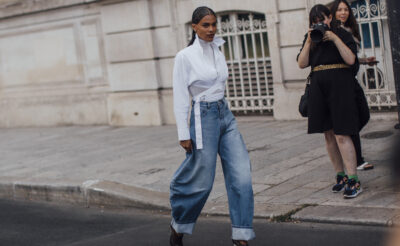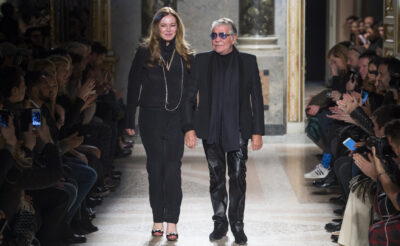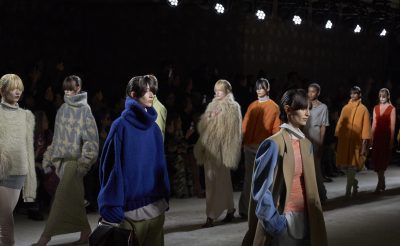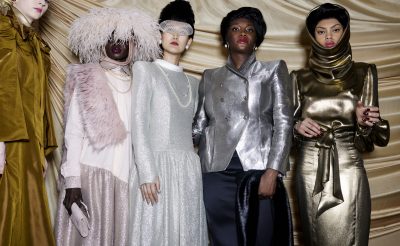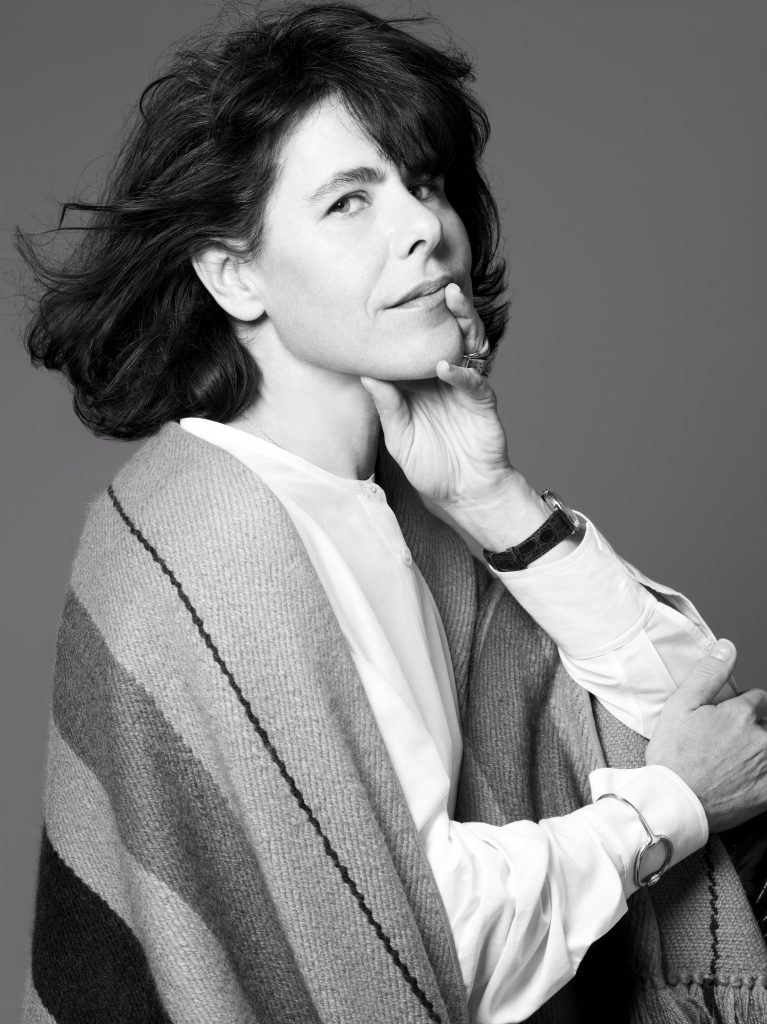
Bali Barret by Liz Collins
Securing an interview with Bali Barret, the deputy artistic director of Women’s Universe at Hermès is a challenge, but when you hear what her daily life consists of it is easy to understand why. She first joined the heritage house in 2003 after a design commission for the iconic Crazy Carré scarf by Pierre-Alexis Dumas, the artistic director of Hermès and sixth-generation member of the founding family, which led to her appointment as artistic director of Feminine Silk. Six years later as Hermès continues to be one of the top-growing luxury brands, she now oversees the creation of all women’s collections: the “universe”, which (as a title alone implies) involves the juggling of daily tasks on a colossal scale. “It is quite a wide role,” she starts, during a call from the Paris headquarters. “It goes from my very first work at Hermès when I was the artistic director of Feminine Silk, to the prêt-à-porter and all accessories including shoes, bags, hats, jewellery, perfume and handbags. Very wide, very rich, very interesting and very varied…” she trails off, pondering the sheer scale of her responsibility before continuing, “Hermès is not one style, one direction, it takes many directions and many different visions and sensibilities and it’s a very interesting job because of that.”
For one woman to oversee so many areas of a maison the size of Hermès is anxiety-inducing for even the most accomplished. In that vein, it is quite appropriate that we are meeting, albeit virtually, to discuss the importance of the aptly-named Crazy Carré – a beautiful silk square, integral to the house, emblazoned with chaotic prints that could well be the perfect metaphor for Bali’s own – by all accounts – crazy life at Hermès.
As her inaugural project, the Crazy Carré remains the area that she is most passionate about for its freedom of artistic expression and its importance to the history of Hermès – also, I suspect, because it quenches the thirst of a mind that is busy with myriad colours and creativity. “For me, the scarf is like a square of liberty where you can express many ideas, many manners and many ways of drawing,” she confirms. “It’s a colour shock. Colour is something that is very important for me because that is the first thing you see – you first have a colour shock before you understand what you see.” Of course, it is not just Bali who is responsible for coming up with the ideas of the prints. “We work on the scarves with about 50 different illustrators from all around the world – that is a very rich team,” she says, which in part explains why the process of producing a scarf design that is just so, can sometimes take up to three years from start to finish.
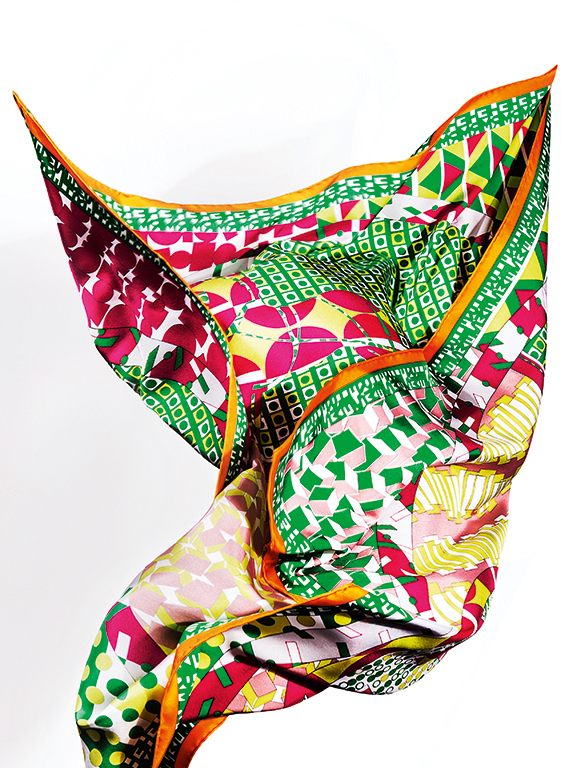
The Ex-libris en Cravats Crazy Carré scarf by Hermès. Photography by Elena at The Factory
As for her own approach to the storytelling that is so apparent in the iconography and motifs depicted on the silks, she places importance on referring back to the heritage of the house and its equestrian ties, but in the interest of evolution, like all designers, is constantly absorbing what is happening around her. “I am a fashion designer originally so when I start a new collection I have a habit of watching everything around me. I let people, music, books, exhibitions, television, Instagram… inspire me. It’s like an inner mechanic that goes, ‘I’m collecting, collecting, collecting’ and I look at everything I have and I notice I have obsessions, and these become an idea.” A moodboard in your mind, I offer. “Like a library in my mind. For the scarf, meeting with talented designers, artists, illustrators or graphic designers can be a great source of inspiration for me,” she confides. “They really give you envy to work with them.”
Collaborations, therefore, are a big part of life at Hermès and Bali counts herself lucky to have worked on one-time collections with a number of respected artists and designers. “Meeting with artists is always interesting as I feel like I am entering their minds, so it is quite exceptional for me and very nurturing,” she says, citing Hiroshi Sugimoto’s collaboration for Hermès Editeur (a bridge between craftmanship and contemporary artists) as one of the strongest. “The idea was meeting the desire of this artist with our craft – what we aimed for was to realise the wish of an artist whatever it was. He [Hiroshi Sugimoto] has a lot of humour and he really likes to challenge people,” she pauses. “We were expecting him to come along with a black-and-white photograph, like the previous work we knew from him, however he came with a photo, all shades of colour, which is a nightmare for a printer. He said, ‘do you think you can do it?’ and I said, ‘we can try’ and we did it. And from that moment he had so much respect for us. He said, ‘You would fail, I was sure!'” she tells me excitedly.
It is challenges and partnerships like this that keep Bali, and Hermès, innovating and remaining relevant in a world where luxury brands are struggling to keep up with the shift in spending from goods to experiences. It is now more important than ever to show past, present and future generations of consumers just how desirable a brand can be through creativity, clever associations and the all-important fashion event, complete with plentiful Instagramopportunities. This idea does not elude Bali. “Sometimes the inconvenience of being an old house is that young people think that you are old and boring and the idea is to show people that we are not old and boring, but fun and contemporary,” she says, honestly.

Inside the Hermès Crazy Carre event held in Dubai in October 2017.
Enter the Crazy Carré event series. If you want to know what it is like to get inside a kaleidoscopic mind like hers, then the Crazy Carré events are the perfect introduction. Large-scale productions in the world’s most major cities, including Madrid, Shanghai and, this year Dubai, where Hermès takes over a venue, in our case Dubai Opera, and transforms it in to a silk universe, showcasing curated edits of the house’s scarves in rooms designed to bring the story of their prints to life. “The idea behind Crazy Carré was to give our customers, journalists and friends the chance to experience the 3D story of the scarf. We always talk about storytelling but through the Crazy Carré event we wanted them to be a part of it. The idea was to make a one-dimensional design in 3D and to live the experience of the storytelling.”
Choosing Dubai as the latest destination for the event was a calculated move that, aside from celebrating the heritage of one of the brands most beloved by the region, also acted as a platform to introduce the ever-evolving world of the Crazy Carré to a city where the scarf is worn as more than just an accessory. “In the Middle East you have a very strong tradition of scarves – women wear a lot of scarves, maybe more than anywhere else. That was one of the reasons we chose Dubai as the next destination for Crazy Carré, because we have an audience over there,” she says. “It was an opportunity for us to go there and meet our customers. It also allowed us to showcase the Hermès Carré to a younger generation in a playful way.” Scrolling through images of the night on social media it looks like it worked. If it’s a colour shock you need, you know where to look.

